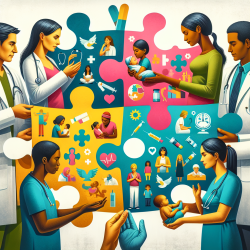Introduction
In the quest to improve maternal and child health (MCH) outcomes, the role of local health departments (LHDs) is pivotal. Recent research by Quinlan, Mitchell, and Mays (2023) highlights the significance of collaboration between LHDs and social service organizations in enhancing community health outcomes. This blog explores the findings of their study and offers actionable insights for practitioners aiming to elevate their impact in MCH services.
The Power of Collaboration
The study reveals that LHDs providing direct MCH services exhibit greater collaboration with social service organizations, thereby enhancing community capacity to address health disparities. This collaboration is crucial in tackling the social determinants of health, which significantly impact maternal and child health outcomes.
Key findings include:
- 85% of LHDs provided at least one MCH service, with services like the Special Supplemental Nutrition Program for Women, Infants, and Children (WIC) being the most common.
- LHDs that provide MCH services are more likely to collaborate with social service organizations across various domains, including basic needs, special populations, and criminal justice.
- High collaboration levels are associated with better engagement with organizations providing essential services, such as housing, food, and support for vulnerable populations.
Challenges and Opportunities
Despite the positive correlation between MCH service provision and collaboration, the study identifies challenges, particularly in rural areas and communities with high maternal vulnerability. These areas often exhibit lower collaboration levels, highlighting the need for targeted strategies to enhance partnerships and service delivery.
Practitioners can leverage these insights by:
- Fostering partnerships with local social service organizations to address the comprehensive needs of mothers and children.
- Advocating for policy changes that support resource allocation to underserved areas.
- Utilizing data-driven approaches to identify and address gaps in service provision and collaboration.
Implications for Practitioners
For practitioners in the field of speech-language pathology and other health services, this research underscores the importance of cross-sector collaboration. By integrating efforts with social service organizations, practitioners can contribute to a holistic approach that addresses both medical and social determinants of health.
Practitioners are encouraged to:
- Engage in continuous professional development to understand the dynamics of community health networks.
- Participate in community-based initiatives that promote maternal and child health.
- Advocate for and implement evidence-based practices that enhance collaborative efforts.
Conclusion
The study by Quinlan et al. (2023) provides a compelling case for the power of collaboration in improving maternal and child health services. By embracing partnerships and focusing on data-driven strategies, practitioners can play a vital role in reducing health disparities and fostering healthier communities.
To read the original research paper, please follow this link: Who Delivers Maternal and Child Health Services? The Contributions of Public Health and Other Community Partners.










